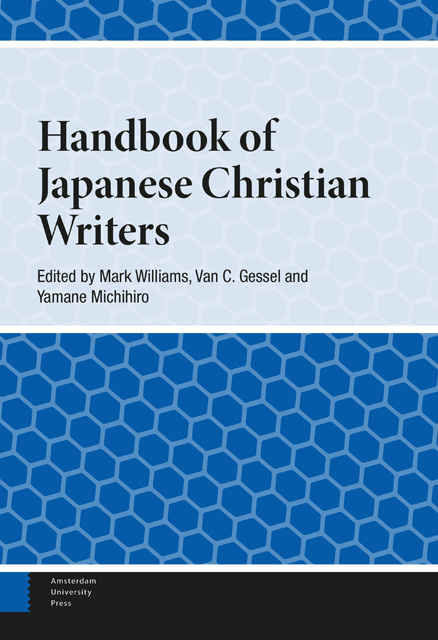Book contents
- Frontmatter
- Contents
- Contributors
- Abbreviations
- Preface
- Introduction
- 1 Prophet of the Inner Life: Kitamura Tōkoku
- 2 Shimazaki Tōson and Christianity: When the Cherries Ripen in the Taishō Period
- 3 Arishima Takeo and Christianity
- 4 Akutagawa Ryūnosuke: A Christian Life
- 5 Incarnation of the Christian Faith in the Poetry of Yagi Jūkichi
- 6 Hori Tatsuo: The Cross Dyed in Bloody Red and the Little Gods of Ancient Times
- 7 Nagai Takashi on Divine Providence and Christian Self-Surrender: Towards a New Understanding of hansai
- 8 Dazai Osamu: His Wrestle with the Bible
- 9 Shiina Rinzō: His Two Visages
- 10 From out of the Depths: Shimao Toshio’s Literary Response to Adversity
- 11 Yasuoka Shōtarō and Christianity: From Postwar “Emptiness” to Religious Longing
- 12 Miura Ayako and the Human Face of Faith
- 13 Endō Shūsaku and the Compassionate Companionship of Christ
- 14 Ogawa Kunio: Renewal of Faith and Identity in His seishomono (Bible Stories)
- 15 Kaga Otohiko: In Search of What Lies Beyond Death
- 16 Sono Ayako: Amor Vincit Omnia
- 17 Takahashi Takako: Drawing Closer to God Through Literature
- Index
- Index of titles
4 - Akutagawa Ryūnosuke: A Christian Life
Published online by Cambridge University Press: 09 June 2023
- Frontmatter
- Contents
- Contributors
- Abbreviations
- Preface
- Introduction
- 1 Prophet of the Inner Life: Kitamura Tōkoku
- 2 Shimazaki Tōson and Christianity: When the Cherries Ripen in the Taishō Period
- 3 Arishima Takeo and Christianity
- 4 Akutagawa Ryūnosuke: A Christian Life
- 5 Incarnation of the Christian Faith in the Poetry of Yagi Jūkichi
- 6 Hori Tatsuo: The Cross Dyed in Bloody Red and the Little Gods of Ancient Times
- 7 Nagai Takashi on Divine Providence and Christian Self-Surrender: Towards a New Understanding of hansai
- 8 Dazai Osamu: His Wrestle with the Bible
- 9 Shiina Rinzō: His Two Visages
- 10 From out of the Depths: Shimao Toshio’s Literary Response to Adversity
- 11 Yasuoka Shōtarō and Christianity: From Postwar “Emptiness” to Religious Longing
- 12 Miura Ayako and the Human Face of Faith
- 13 Endō Shūsaku and the Compassionate Companionship of Christ
- 14 Ogawa Kunio: Renewal of Faith and Identity in His seishomono (Bible Stories)
- 15 Kaga Otohiko: In Search of What Lies Beyond Death
- 16 Sono Ayako: Amor Vincit Omnia
- 17 Takahashi Takako: Drawing Closer to God Through Literature
- Index
- Index of titles
Summary
Akutagawa Ryūnosuke was born in an area adjacent to the foreign residents’ settlement in Tsukiji. In accordance with tradition both his parents were deemed to have been born in “unlucky” years, so he found himself abandoned on the steps of the church diagonally opposite the family home. He ended up taking his own life at the age of 35, with his final works including The Man from the West, which represented his personal views on Christ. At the same time, he left a copy of the Bible by his pillow as he died. In this sense, Christianity can be seen as pervading his entire life. However, because Akutagawa himself claimed to love Christianity “artistically,” this element of his writing has been largely ignored in critical discussions. There is no disputing the profundity of the influence that Christianity exercised on Akutagawa and this chapter will seek to capture the full extent of the author's interaction with the faith by examining the numerous stories that betray the shadow of Christianity, including more than a dozen so-called Kirishitanmono. The chapter ends with an attempt to summarize the issue of Christianity as it impinges on Akutagawa's life and literature.
Introduction: The life of Akutagawa Ryūnosuke
Akutagawa Ryūnosuke (1892–1927) stands as one of the representative authors of modern Japanese literature. Having begun his literary career at the outset of the Taishō era (1912– 1926), he ended up taking his own life in 1927, some eight months into the ensuing Shōwa era. Having lived through the Taishō years, he was only 35 years of age. His relationship with Christianity is filled with fascinating details. In keeping with the local custom with regard to children born in so-called unlucky years, he was abandoned as a baby—only to be discovered in front of the church diagonally opposite his home. He may have taken his own life; but his final work, “Seihō no hito” (The Man from the West,* 1927) can be seen as depiciting his own personal views on Christ; equally noteworthy is the fact that the last book that he looked at was the Bible.
Akutagawa was born on 1 March 1892 in the Irifune district of the Kyōbashi suburb of Tokyo (what is now known as Akaishi-chō in Chūō-ku in central Tokyo), the eldest son of Niihara Toshizō (born 1850) and Fuku (born 1860).
- Type
- Chapter
- Information
- Handbook of Japanese Christian Writers , pp. 64 - 83Publisher: Amsterdam University PressPrint publication year: 2022

